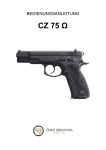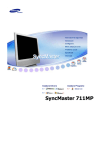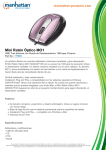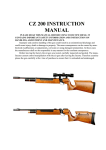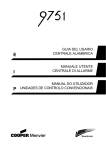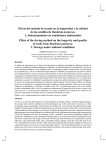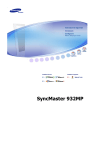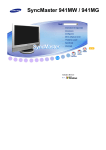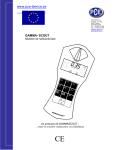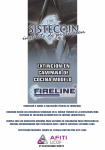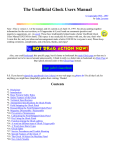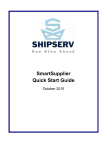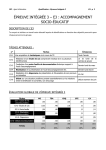Download Manual Pistola CZ P09 Angel Guardian
Transcript
Before handling the pistol read this manual carefully and observe the following safety instructions. Improper and careless handling of the pistol could result in unintentional discharge and could cause injury, death or damage to property. The same consequences can be caused by unauthorized modifications or adjustments, corrosion, or use of non-standard or damaged ammunition. In these cases the manufacturer shall not be responsible in any manner whatsoever for the resultant consequences. Before leaving the factory this pistol was tested, carefully inspected, and packed. CZ cannot accept responsibility for product handling while in transit, or upon leaving the factory. Therefore, please examine this pistol carefully at the time of purchase to ensure that it is unloaded and undamaged. This instruction manual should always accompany this pistol and that even in the case of the loan or sale of this pistol. CONTENTS SAFETY INSTRUCTIONS PISTOL DESCRIPTION AND TERMINOLOGY Safety Features OPERATING INSTRUCTIONS Ammunition Removal of the Magazine Magazine Loading Pistol Loading Reloading During Shooting Unloading the Pistol Engaging the Safety Mode Decocking Sight Adjustment Changing the Back Strap Inserts MAINTENANCE INSTRUCTIONS Stripping for Cleaning - Disassembly Magazine Disassembly Exchange of Control Elements Cleaning the Pistol Cleaning the Barrel Bore and the Cartridge Chamber Cleaning of Other Pistol Parts Preserving Waste Management LIST OF PARTS TROUBLESHOOTING, CAUSES AND REMEDIES TECHNICAL SPECIFICATIONS LIST OF ILLUSTRATIONS 2 3 6 7 7 7 7 8 8 8 8 8 9 9 9 10 10 10 11 11 11 12 12 12 13 14 15 15 SAFETY INSTRUCTIONS Always follow the safety instructions for your safety and the safety of others. 1. Always handle your pistol as if it were loaded. 2. Never point your pistol at anything you do not intend to shoot. 3. Never take anyone's word that a gun is unloaded. 4. Always make sure that your pistol is not loaded before laying it down, or handing it to another person. 5. Always keep and carry your pistol empty, with the hammer forward except when you intend to shoot. 6. Never abuse your pistol by using it for any purpose other than shooting. 7. Never leave the pistol cocked and ready to fire unattended. 8. Before loading your pistol be sure that the barrel bore, chamber, and action are clean and clear of obstructions. After shooting, clean the dirtied pistol as soon as possible. 9. Always use only clean, dry, original high quality commercially manufactured ammunition, which is appropriate to the caliber of your pistol. 10. Never drink alcoholic beverages or take drugs before or during shooting. 11. Always wear safety glasses and ear protection when shooting. 12. Always keep the safety on when the pistol is loaded and cocked, until you are ready to fire. Keep your pistol pointed in a safe direction when disengaging the manual safety. 13. Always keep clear and keep others clear of the ejection port. 14. Never squeeze the trigger or put your finger in the trigger guard until you are aiming at a target and ready to shoot. 15. Always be absolutely sure of your target, and the area behind it, before you squeeze the trigger. A bullet could travel through or past your target up to several hundred meters. 16. Never shoot at a hard surface such as rock, or a liquid surface such as water. 17. Never fire your pistol near an animal unless it is trained to accept the noise. 18. Never indulge in "horseplay" while holding your pistol. 19. Failure to fire: In case of failure to fire hold the firearm keeping it pointed towards the target, or a safe open area and wait 30 seconds. If a hangfire (slow ignition) has occurred, the cartridge will fire within 30 seconds. If the cartridge does not fire, eject the cartridge and examine it. If the firing pin indent on the cartridge is light, or nonexistent, have the firearm examined by a competent gunsmith. 20. Always make sure your pistol is not loaded before cleaning, storing or travelling. 21. Always keep and store your pistol and ammunition in separate locked receptacles out of reach and sight of children and untrained people. 3 22. Never alter any parts of your pistol as the safety and proper function of your pistol could be seriously compromised. 23. Always be aware that corrosion, use of damaged ammunition, dropping the pistol on hard surfaces or other "coarse treatment" could cause damage you may not see. If something like this happens allow the pistol to be examined and tested by a competent gunsmith. RULES OF THE SAFE HANDLING TRITIUM SIGHTS The tritium sights MEPROLIGHT type ML-17777 for CZ pistols involve a luminous front sight (tritium radiator of 0,565 GBq activity) and a luminous rear sight (2 tritium radiators of 0,444 GBq activity) that is installed at the pistol by means of precision dovetails. Tritium in the gaseous state (99% HT and 1% HTO) is enclosed in borosilicate glass ampoules with a luminescent element and these ampoules are fixed by glue into the metallic cap of the sight so that the manipulation and storage of the sights is not exposed to any risks. The third generation of the sights retains all the advantageous features of the preceding generation of MEPROLIGHT sights and several improvements are added: - - built-in shock absorber solid protective bushing providing less sensitivity against rough manipulation immovable crystal window for a better light output with additional protection against a damage tolerance against longer immersion in currently used solvents and cleaning agents guaranteed continuous available light intensity for the period of 12 years MV sealing design (the only design tested and approved by Israel armed forces) protects the sights against an accidental damage, avoids the unwanted manipulation with the light source, inhibits to penetrate the dirt into the visual system and to hide the light provided a finer transition between the aiming during the day and the night simple installation (no modification of the arm is necessary) no added weight nor size no maintenance no battery needed (no losses of the energy at the cold weather) Safety instructions in case of the sights damage In regular conditions of the storage, use and maintenance there is no risk to the user caused by emitted ionizing radiation, because it doesn't penetrate metallic caps, in which the ampoules with radiators are fixed. In case of a nearly unreal incidental damage of all ampoules in one set at the moment, when the arm is in shooting position (position of the sights closer to the shooter), the single effective radiation dose wouldn't exceed the value of 0,26 mSv. What does this value present? It is for example: 4 - 1/12 of the dose which is received by an ordinary inhabitant in course of a year - due to the natural radioactive background (3,5 mSv / year) less than 1/4 of the general effective dose limit to an ordinary inhabitant Recommended first aid at the inspiration of the gaseous tritium The gaseous tritium state is practically inactive and causes a slight internal contamination. In case of its inspiration it is recommended to increase the intake of liquids and eventually to take some diuretic (beer with low content of alcohol) for acceleration of the body water exchange. DUTIES OF THE TRITIUM SIGHTS OWNER 1. The sights are a radioactive radiator in the period of 6,5 years since their purchase according to the Czech Republic legislation. 2. At the purchase the owner obtains a guide with rules of the safe handling and a document on the on the impermeability of the radionuclidic radiators in the set (certificate of the encased radionuclidic radiator), which must be preserved and presented on request of the competent authority. 3. When handling a type approved product, which is the source of the ionizing radiation, it is necessary to respect national regulations for protection against he ionizing radiation (the appropriate national legislation). 4. In case of the ownership of more than 9 sets of sights (the total activity exceeding 10 GBq) the owner is obliged to consult the duties resulting from the appropriate national legislation at the competent authority. 5. To avoid such manipulation, when a rough mechanical damage of the sights may happen. 6. It is not allowed to carry out any changes, relating to the properties of the protection against the radiation. 7. In case of the destruction or the damage, the sights mustn't be further used. The owner is obliged to secure safely the device changed in such a way and to pass it to the distributor or the manufacturer for the safe liquidation. The same procedure to be applied for liquidation of no more used sights. 8. The manipulation with sights is governed by general principles of the protection against the ionizing radiation. At the current use there are no requested tests of impermeability during the service life of the sights. The sights were type approved by the decision of the competent authority Ref. No. 25169/2005, index A1. Company, eventually the responsible company representative: Ing. Ladislav Britaňák 5 PISTOL DESCRIPTION AND TERMINOLOGY The names of basic pistol parts used in this Instruction Manual are presented in Fig. 1 on the inner side of the left-hand cover. Nomenclature of all CZ P-09 parts are presented in the section List of Parts. The CZ P-09 pistol is a semi-automatic handgun incorporating short recoil, designed for aimed shooting up to 50 m distances. The CZ P-09 utilizes the locked breech principle. It is fitted with a trigger mechanism adapted to operate both in SA and DA modes of fire, a firing pin safety, safety stop on the hammer and manual safety which can be easily disassembled and substituted by a hammer decocking element. The frame is made from plastic material. Characteristic features of the CZ P-09 are: - Comfortable grip and balance in either hand Good results at instinctive shooting (without aiming) Low trigger pull weight High accuracy of fire Long service life High reliability, even with various types of cartridges Sights adapted also for aiming under reduced visibility conditions The slide stays open after the last cartridge has been fired Suitable for everyday service gun toting The standard pistol version provided with ambidextrous safety or ambidextrous decocking element Mutual interchangeability of the safety and hammer decocking element The front part of the frame provided with grooves for applying special accessories Each pistol is supplied with these items: - - 2 pieces of magazines (the number of magazines can differ for particular versions of the pistol) set of interchangeable back strap inserts interchangeable control elements (safety/hammer decocking lever controller) maintenance and cleaning instruments (cleaning brush, cleaning rod, key for sights adjustment, polymer case) documents related to the pistol (instruction manual, CD containing promotion files and instruction manuals in various languages, warranty certificate/card, grouping paper) padlock (only in selected versions) 6 Comments: SA (Single Action) The trigger mechanism operates in a single action mode of fire. The hammer is cocked manually and then after pressing the trigger the pistol is fired. The trigger travel is short, and pull weight is low. After each discharge the hammer remains cocked. DA (Double Action) The trigger mechanism operates in a double action mode of fire. The hammer is cocked, released and the pistol fired by one pull of the trigger. The trigger travel is longer, and trigger pull weight is higher than at SA mode of fire. Safety Features Trigger Guard Prevents unintentional pressing of the trigger, for example when the pistol is dropped. Inertia Firing Pin The design of the firing pin prevents the firing pin from protruding through the face of the slide when the hammer is in its rest position. This eliminates the possibility of a discharge when a loaded pistol is dropped on the hammer. Firing Pin Safety The firing pin safety keeps the firing pin blocked until the trigger is pulled. This safety device minimizes the risk of accidental discharge through mishandling such as when a loaded pistol is dropped. Safety Stop on the Hammer A half-cock safety notch is on the hammer so as to prevent it from striking the firing pin when the hammer is manually cocked, and a thumb could slip. When the hammer is on the safety stop, it is not leaning against the firing pin stop, but its position is further back. OPERATING INSTRUCTIONS Ammunition Use only factory-manufactured ammunition of appropriate caliber, which are in compliance with CIP regulations (International Proof Commission for Firearms) or SAAMI (Sporting Arms and Ammunition Manufacturers' Institute Inc. of the United States). The use of other cartridges could damage the handgun or cause injury to the shooter. Removal of the Magazine Grip the pistol in your right (left) hand and by the thumb (middle finger) depress the magazine catch (Fig. 2). The magazine disengages and falls out of the frame. This pistol model is equipped with the user type magazine catch which can be reversed by gunsmith for the right or left hand operation. 7 Magazine Loading With the open end uppermost, grasp the magazine in one hand. Place a cartridge on the magazine follower. Press the cartridge down and back until it touches the rear flat edge of the magazine. Place the next cartridge on top of the previous cartridge and press down and back. We recommend that when some cartridges are already loaded in the magazine, depress them slightly with the thumb of the hand which holds the magazine. The number of cartridges can be checked through the inspection holes in the sides of the magazine. Do not try to exceed the magazine capacity - doing so can cause a feeding failure. Pistol Loading ALWAYS MAKE SURE THE PISTOL IS POINTED IN A SAFE DIRECTION WHEN LOADING! Insert a loaded magazine and ensure that it has engaged the magazine catch. Hold the pistol by the grip with one hand, and with the thumb and index finger grasp the serrated finger grips on both sides of the slide. Retract the slide to the stop and allow it to snap forward (Fig. 3). This procedure cocks the hammer and inserts a cartridge into the chamber. The pistol is now ready to fire. If you do not intend to fire immediately, ensure the pistol safety by some of the methods mentioned in the section: Engaging the Safety Mode or as per section Decocking. Reloading During Shooting When the last cartridge has been fired the slide will stay to the rear. Remove the emptied magazine and replace it with a loaded one. Thumb down the slide stop with the shooting hand (Fig. 4), or with the other hand draw back the slide and allow it to snap forward. The pistol is again loaded and ready to fire. Unloading the Pistol ALWAYS MAKE SURE THE PISTOL IS POINTED IN A SAFE DIRECTION! - Remove the magazine Draw back the slide and verify the last cartridge has been extracted from the chamber and ejected Let the slide snap fully forward Depress the trigger (dry fire) Engaging the Safety Mode The version equipped with a decocking device is not covered in this section! Push the safety up to the Safety-On position (Fig. 5) until the red warning dot is covered. The safety in this position blocks the trigger mechanism and slide, thus preventing the pulling of the trigger and operating the slide. The safety lever can be set to the "Safe" position even with the hammer on safety notch. However, it is not recommended that the safety be engaged while in this state as any forced cocking of the hammer could damage the 8 trigger mechanism. The pistol safety shall be only engaged with the hammer in its rear position, i.e. cocked. The use of safety is therefore convenient for short interruptions of firing only. Besides the method previously described it is possible to put the pistol into a safety mode and still be ready to fire immediately: Load the pistol. Grasp the grip, POINT IN A SAFE DIRECTION. With thumb press on the grooved area (thumb piece) of the hammer, pull the trigger and release the hammer slowly ahead (Fig. 6) until it rests on the action or safety thumb of the hammer. Release the trigger. Practise this operation very carefully to avoid an accidental discharge! We strongly recommend to practise this operation beforehand with the pistol unloaded! In this state the pistol is safe for all normal handling and at the same time ready for immediate use. Please remember that the safest way to secure a pistol is to unload it and store it in a safe place! Decocking The version equipped with a manual safety is not covered in this section! MAKE SURE THE PISTOL IS POINTED IN A SAFE DIRECTION and thumb down the decocking control lever (Fig. 7). Pressing down the decocking control lever actuates the lowering of the hammer from the cocked position to the hammer safety notch position, without any need to pull the trigger. Even if there is a cartridge in the chamber the pistol is (hammer decocked) safe for all normal handling in this state, and ready for immediate use in a Double Action mode of fire. Sight Adjustment The pistol sights were sighted in at the manufacturing plant at a distance of 25 m so that the mean point of impact approximately conforms to the point of aim. Windage correction can be carried out by the drifting of the rear sight in the dovetail and then secured in its position by an indentation. Elevation correction is carried out by exchanging the front sight for higher or lower sizes. Changing the Back Strap Inserts Each pistol is supplied with a set of changeable back strap inserts, which enables the rear part of the grip to be adjusted according to the individual needs of the user. In order to change the back strap inserts it is necessary to remove the main spring plug pin. To avoid injuries be very careful when removing the pin as it secures the main spring plug as well as the compressed main spring. Entrust the task to a gunsmith. 9 MAINTENANCE INSTRUCTIONS Stripping for Cleaning - Disassembly POINT YOUR PISTOL IN A SAFE DIRECTION! 1. Remove the magazine. The pistol must not be disassembled with the magazine inserted! 2. Put the safety to "OFF" position, in order to release the movement of the slide. 3. MAKE SURE THAT THERE IS NO CARTRIDGE IN THE CHAMBER! 4. Retract the hammer slightly back and then release it, until it stops on half-cock (safety) notch position. In this state the handling which follows will be easier. 5. Put your left thumb through the trigger guard and with the other fingers grasp the top of the front part of the slide firmly. 6. Push the slide slightly rearwards until the rear of the slide is against the retracted hammer and the guidelines on the frame and the slide are in line. 7. Push (tap) the slide stop from the right hand side of the weapon, i.e. using the magazine base (Fig. 8). Remove the slide stop from the left. 8. Pull the slide and the barrel forward off the frame. 9. Remove the recoil spring and finally the barrel. No further disassembly is needed for routine maintenance. When a great number of cartridges has been fired, it is advisable to also disassemble magazine and to entrust the pistol to a competent gunsmith for the firing pin cleaning. Magazine Disassembly To remove the magazine base, push on the base lock which sticks out through a hole in the base and slide the base about 5 mm towards the front of the magazine. Cover the base with your thumb to prevent losing the magazine spring and with the other hand take off the base from its guiding rails. Be careful during the disassembly as the spring could fly out, or even cause an injury. 10 Exchange of Control Elements The pistol is designed in such a way that it enables an easy exchange of the safety by the hammer decocking element and reversely. This operation can be done without using any special tooling. The left safety or left decocking element can be removed first after depressing the ejector downward. Before assembling the right safety or right decocking element it is necessary to depress the trigger bar downward. In the safety configuration only safeties are installed. In case of the decocking configuration besides the control elements, it is necessary to install also the spring of the control element so that its shorter end is supported by the nose of the control element body and the opposite end is positioned in the pin hollow (Fig. 9). It is recommended to pass the training of the control elements exchange under supervision by an experienced gunsmith or to refer to the guidance on the website of Ceska zbrojovka. CAUTION: No further disassembly of your pistol is recommended. Should your pistol require adjustment or repair be sure the task is entrusted to a competent gunsmith! Cleaning the Pistol - Clean the pistol Each time you use it If you get your pistol wet As soon as possible after shooting At least once a year in a temperate climate As often as once a month in a tropical climate, or other demanding environment Cleaning the Barrel Bore and the Cartridge Chamber If the pistol has not been fired or if only a few cartridges have been fired, clean the barrel bore and cartridge chamber by the clean patch attached to the cleaning rod. Repeat the cleaning, changing patches, until the last patch comes out clean. When the barrel bore is very dirty, apply a gun cleaning solution using a cleaning brush. Let the solvent act for about 10 minutes (this time may vary depending on the solvent agent being used). Then thoroughly scrub out the barrel bore. Subsequently, dry the barrel bore and cartridge chamber with a clean patch and check that all powder residues or fouling have been removed. If necessary repeat this procedure. The cleaning rod and the brush must be inserted into the barrel bore from the chamber, to prevent wear or damage to the muzzle. Pass the brush all the way through the barrel bore before reversing the movement. If you try to change directions with the brush in the barrel, the brush could stick. 11 Cleaning of Other Pistol Parts Other parts of the pistol (including the external surfaces of the barrel) should be cleaned with a dry cloth, old toothbrush, brass bristle brush or a wooden scraper. Preserving oil or paraffin oil can be used for proper cleaning. Never use the agent designed for barrel bore cleaning! These solutions could remain in the joints, and after some time could cause corrosion. Check that cloth particles or brush bristles have not become lodged in any part of the pistol. Preserving When the barrel bore, cartridge chamber, and all accessible parts are clean and dry, wipe these parts with a cloth soaked in gun oil or apply the oil in a spray. Remove all excess oil. Before shooting always wipe the barrel bore dry. At very low temperatures remove the oil from all accessible parts or apply a lubricant prepared especially for these conditions. Use thick preserving agents for example, preserving grease only for a long-term storage in demanding climate environments, and before any use of the pistol it must be thoroughly removed from all parts of the firearm. Waste Management When used properly, the materials used in the product and packaging have no adverse effects on human health or the environment. When disposing of the product or its packaging, metal parts (steel and non-ferrous metals), plastics, wood, paper and cardboard should be stored separately in collecting containers intended specifically for that purpose. The Company, reserves the right to make any changes it thinks necessary to improve its models or to meet any requirements of manufacturing or commercial nature. 12 LIST OF PARTS 1 a) Frame 25 Front Sight b) Changeable Back Strap 26 Main Spring Strut Insert S/M/L 27 Main Spring Plug 2 Slide 28 Sear Pin 3 Barrel 29 Hammer Pin 4 Slide Stop 30 Trigger Pin 5 Magazine 31 Magazine Catch Plug 6 Insert - Front 32 Main Spring Plug Pin 7 Insert - Rear 33 Extractor Pin 8 Trigger 34 Magazine Catch Pin 9 Trigger Bar 35 Insert - Front Pin 10 Sear 36 Pin 11 Hammer 37 Firing Pin Plug 12 Disconnector 38 Recoil Spring Assembly 13 Firing Pin Block Lever 39 Securing Screw (2x) 14 Trigger Bar Disconnector 40 Extractor Spring 15 Ejector 41 Firing Pin Spring 16 Firing Pin 42 Firing Pin Block Stop Spring 17 Extractor 43 Spring (2x) 18 Firing Pin Block Stop 44 Slide Stop Spring Pin 19 Magazine Catch 45 Main Spring 20 Safety - Left * 46 Trigger Spring 21 Safety - Right * 47 Slide Stop Spring 22 Hammer Decocking Lever 48 Hammer Decocking Lever Spring * Controller - Left * 49 Trigger Bar Spring 23 Hammer Decocking Lever 50 Sear Spring Controller - Right * 51 Insert - Rear Pin 24 Rear Sight * The parts marked * differ according to versions, or as case may be in some versions are entirely missing. 13 TROUBLESHOOTING, CAUSES AND REMEDIES If your pistol is properly used and maintained, malfunctions will rarely occur. However, if such a situation does occur, please observe the following instructions. CAUTION - If a malfunction occurs, the possibility of unintentional discharge is substantially increased. For this reason, carefully observe the Safety Instructions already mentioned above. Keep the pistol pointed in a safe direction, do not turn the pistol against your body or anyone else’s! Do not place your hands in front of the barrel! If you use your pistol for self-defense, or in law enforcement, please acquire so-called “dummy cartridges” and practice fast clearing of malfunctions as described below. Malfunction Possible Cause Remedy Magazine is not fully inserted or is damaged. Insert magazine properly or change magazine. The pistol or cartridges are fouled (dirty) or too heavily greased. Clean the pistol and cartridges and wipe them dry or as case may be slightly lubricate. Defective cartridge. Pull the trigger again. If a discharge is not initiated, follow the Safety Instructions according to point 19. Misfire Firing pin hole fouled (dirty) or unproper lubrication agent used under low temperature conditions. Disassemble and clean the firing pin or use a low temperature lubricant. A shot sounds "weak" combined with failure to eject the cartridge case The cartridge has been activated but no powder load was inside the cartridge case. Unload the pistol and check that the bullet is not lodged in the barrel. A subsequent shot could cause damage to the barrel. The spent case has not been ejected Cartridge chamber, extractor or ammunition dirty, or unsuitable lubricant in low temperature environment. Clean and wipe the pistol dry or lubricate lightly with a suitable agent. Use new and clean ammunition. A cartridge has not been fed into the chamber or the slide has not fully locked with the barrel If you cannot clear away any malfunction in the manner described above, entrust the pistol to a competent gunsmith for inspection and repair. 14 TECHNICAL SPECIFICATIONS 9 x 19 9 x 21 Caliber .40 S&W Overall length [mm] 205 -2 205 -2 Height [mm] 148 ± 1,5 148 ± 1,5 Width * [mm] Frame Weight with empty magazine [g] 37 ± 1 37 ± 1 Polymer Polymer max. 860 max. 860 Barrel length (without glide ramp) [mm] 115 -1 115 -1 Sight radius [mm] 170 ± 2 170 ± 2 Magazine capacity ** 19 15 Trigger pull (SA) [N] 14,7 - 24,5 14,7 - 24,5 Trigger pull (DA) [N] max. 58,9 max. 58,9 * ** [cartridges] Measured with ambidextrous safety eventually with ambidextrous decocking element To some countries, the CZ P-09 pistols are supplied with a reduced magazine capacity in compliance with local laws LIST OF ILLUSTRATIONS 1. The names of basic parts 2. Removal of the magazine 3. Pistol loading 4. Slide release from its "rear lock-up" position by depressing slide stop 5. Shifting the safety to the "SAFETY-ON" position 6. Release of the hammer in the version equipped with the manual safety 7. Release of the hammer in the version equipped with no manual safety 8. Slide stop removal using the magazine base 9. Detail of the hammer decocking element installed 15 Antes de manipular con la pistola, lea cuidadosamente este manual y observe especialmente las siguientes instrucciones de seguridad. Un manejo incorrecto y descuidado de la pistola podría producir un disparo no intencionado causando lesiones corporales, muerte o daños a la propiedad. Las mismas consecuencias pueden tener modificaciones no autorizadas, corrosión o uso de una munición no prescrita o averiada. El fabricante no se hará responsable por las consecuencias originadas en estos casos. Antes de abandonar la fábrica, la pistola fue probada, revisada cuidadosamente y empaquetada. CZ no puede controlar la manipulación del producto una vez que el mismo abandone la fábrica. Por esta razón, al comprar esta pistola verifique que la misma esté descargada y sin averías. Este Manual de Instrucciones deberá siempre acompañar la pistola, incluso cuando el arma fuese prestada o vendida. CONTENIDO INSTRUCCIONES DE SEGURIDAD TERMINOLOGÍA Y DESCRIPCIÓN DE LA PISTOLA Elementos de seguridad de la pistola INSTRUCCIONES DE USO Munición Retiro del cargador Cargar el cargador Cargar la pistola Recarga durante el tiro Descargar la pistola Seguro de la pistola Soltar el martillo (Decocking) Ajuste de miras Recambio de lomos de la empuñadura INSTRUCCIONES DE MANTENIMIENTO Desmontaje del arma para la limpieza Desmontaje del cargador Recambio de elementos de manejo Limpieza de la pistola Limpieza del ánima y la recámara Limpieza de otras partes de la pistola Conservación Tratamiento de los residuos LISTA DE COMPONENTES ELIMINACIÓN DE FALLAS FUNCIONALES DATOS TÉCNICOS LISTA DE GRÁFICOS 16 17 21 22 23 23 23 23 23 24 24 24 25 25 25 26 26 26 27 27 27 28 28 28 29 30 31 31 INSTRUCCIONES DE SEGURIDAD Mantenga siempre las instrucciones de seguridad para su seguridad personal y la de los demás. 1. Manipule siempre con su pistola como si fuese cargada. 2. No apunte nunca a ningún objeto, si no tenga la intención de disparar. 3. No confíe a nadie que la pistola esté descargada. 4. Antes de dejar de utilizar la pistola o entregarla a otra persona, verifique siempre que esté descargada. 5. Almacene la pistola descargada y con el martillo en la posición delantera. 6. No utilice nunca la pistola con otros fines que para disparar. 7. Nunca deje sin vigilancia una pistola cargada. 8. Antes de cargar el arma, asegúrese que el ánima del cañón, la recámara y la corredera estén limpios y sin obstrucciones. Limpie la pistola después del disparo tan pronto sea posible. 9. Utilice siempre una munición limpia, seca y de fabricación original, de alta calidad y en un buen estado, correspondiente al calibre de su pistola. 10. Nunca tome bebidas alcohólicas o utilice estupefacientes antes o durante el disparo. 11. Utilice protectores de oídos y gafas de tiro protectoras durante el tiro. 12. Si la pistola está cargada y con el martillo montado, mantenga el seguro en la posición de seguridad hasta el momento de estar preparado para el disparo. Al quitar el seguro apunte en un espacio seguro. 13. Mantenga libre la ventanilla de expulsión e impida que alguien se coloque en la dirección de la cartuchera expulsada. 14. No presionar el disparador y no introducir los dedos en el guardamonte del disparador, a no ser, que esté apuntando al blanco y preparado para dispararar. 15. Antes de presionar el disparador, vuelva a controlar su objetivo y el espacio posterior del mismo. La bala puede atravesar el objetivo o desviarse fuera del mismo y pasar una distancia de varios cientos de metros. 16. Nunca dispare a una superficie dura, como una piedra, o la del agua por ejemplo. 17. No dispare nunca cerca de un animal que no esté entrenado para este tipo de ruido. 18. Al manipular con la pistola, evite todo tipo de "bromas". 17 19. Falla del disparo: En el caso de no producirse el disparo, mantenga el arma apuntando hacia el blanco de disparar o hacia un espacio seguro y espere treinta segundos. En el caso de producirse una ignición atrasada, el cartucho disparará en treinta segundos. Si no se produciría el disparo, retire el cartucho del cañón y revíselo. Si la huella del percutor en el cartucho es débil o falta, antes de realizar el siguiente disparo deje revisar la pistola por un armero calificado. 20. Asegúrese siempre que la pistola no este cargada cuando vaya a limpiarla, almacenarla o transportarla. 21. Guarde siempre la munición y la pistola en depósitos seguros y bajo llave, fuera del alcance y la vista de los niños o gente no autorizada. 22. Nunca altere ninguna parte de la pistola, podría comprometer de una manera grave el correcto funcionamiento de la pistola o su seguridad. 23. Tenga en cuenta que la corrosión, el uso de munición dañada, el roce del arma con superficies duras u otros rudos movimientos podrían causar daños a la pistola, que no necesariamente se puedan percibir a simple vista. Si algo como esto ocurriera, entregue el arma a un especialista para ser examinada y probada. REGLAMENTOS DE SEGURIDAD PARA EL USO DE MIRAS DE TRITIUM Las miras de tritium MEPROLIGHT de tipo ML-17777 para pistolas CZ forman un juego con un guión luminoso (emisor de tritium de una actividad de 0,565 GBq) y miras luminosas posteriores - el alza (2 emisores de tritium de una actividad de 0,444 GBq), que se ensamblan en el arma a colas de milano exactas. El tritium en su forma gaseosa (99% HT y 1% HTO) se encuentra cerrado en ampollas de vidrio de borosilicato con luminofor, las mismas que se fijan con un pegante en una funda de metal de tal manera, que el uso y el almacenamiento de las miras no representen ningunos riesgos. En la tercera generación de las miras se mantienen todos los elementos de ventaja de la generación anterior de miras MEPROLIGHT y se añaden algunas correcciones: - Un amortiguador de golpes incorporado Un manguito de protección sólido que asegura la disminuída sensibilidad de las miras en caso de una manipulación tosca - Una ventanilla fija de cristal para una mejor salida de luz y mejor protección contra el el daño Resistencia a la sumersión prolongada en disolventes y medios de limpieza de uso corriente Luminosidad garantizada utilizable e ininterrumpida durante el tiempo de 12 años - 18 - - Molde de empaque MV (el único molde ensayado y aprobado por las fuerzas armadas de Israel) protege las miras contra averías casuales, impide la manipulación inadecuada con la fuente de luz, impide la penetración de suciedad al sistema visual y el encubrimiento de la luz Asegura un paso más suave entre el apuntamiento durante el día y en la noche Un montaje sencillo (no requiere de ningunas modificaciones en el arma) No aumenta el peso ni el volumen Sin mantenimiento No necesita batería (no hay pérdidas de energía durante el clima frío) Instrucciones de seguridad en caso de un daño de las miras Bajo condiciones regulares de almacenamiento, uso y mantenimiento de las miras la radiación ionizante emitida no representa ningún riesgo para el usuario, ya que no se filtra a través de las fundas de metal en las cuales se encuentran fijas las ampollas con los emisores. En caso de producirse un daño casual casi irreal de todas las ampollas en un juego de miras en el momento cuando el arma se encuentre en la posición de disparo (la posición, cuando las miras se encuentran más cerca del tirador), la dosis única efectiva no sobrepasaría el valor de 0,26 mSv. Que representa este valor? Por ejemplo, es igual a: - 1/12 de la dosis que un habitante corriente obtiene durante el año del fondo de radiación natural (3,5 mSv / año) es menos que 1/4 del límite general de la dosis efectiva para un habitante corriente Primeros auxilios recomendados en caso de una inhalación del tritium en forma gaseosa La forma gaseosa del tritium es practicamente inerte y causa una moderada contaminación interior. En caso de una inhalación se recomienda aumentar la cantidad de líquidos y también, eventualmente administrar diuréticos (cerveza con bajo contenido de alcohol) para acelerar la vuelta del agua en el cuerpo. OBLIGACIONES DEL PROPIETARIO DE MIRAS DE TRITIUM 1. De acuerdo a la legislación de la República Checa las miras son un emisor radioactivo durante el plazo de 6,5 años desde su adquisición. 2. Al adquirir las miras el propietario del equipo obtendrá un manual con instrucciones de uso seguro y un certificado sobre la hermeticidad de los emisores de radionúclido en el juego (el certificado del emisor de radionúclido cerrado), que debe guardar y presentarlo a las autoridades competentes en caso de ser requerido. 3. Durante la manipulación con el producto de tipo autorizado que es una fuente de radiación ionizante hay que respetar los reglamentos nacionales sobre la protección de la radiación ionizante (la legislación nacional correspondiente). 19 4. En caso de ser propietario de más de 9 juegos de miras (una actividad total que sobrepasa los 10 GBq), el propietario está obligado a pedir a las autoridades competentes la información sobre las obligaciones resultantes de la legislación nacional correspondiente. 5. Evitar tal manipulación que podría causar un grave daño mecánico de las miras. 6. No está permitido realizar tales modificaciones en las miras que podrían alterar propiedades importantes para la protección contra la radiación. 7. La miras no deben seguir utilizándose al ser destruidas o dañadas. El propietario debe recoger con seguridad los equipos así alterados y entregarlos al distribuidor o productor para su liquidación segura. El mismo procedimiento es válido en caso de la liquidación de miras que ya no se utilizan. 8. Para la manipulación con las miras valen las reglas generales de protección contra la radiación ionizante. Durante un uso corriente durante la vida útil de las miras no se requieren pruebas de hermeticidad. El tipo de miras fue aprobado en la República Checa mediante la decisión de la autoridad competente bajo el no. 25169/2005, marca A1. La empresa, eventualmente el representante responsable de la empresa: Ing. Ladislav Britaňák 20 TERMINOLOGÍA Y DESCRIPCIÓN DE LA PISTOLA La denominación de las partes principales de la pistola utilizada en este Manual está indicada en el gráfico No. 1 en la parte interior de la tapa del libro. La denominación de todos los componentes de la pistola está indicada en el capítulo Lista de componentes. La pistola CZ P-09 es un arma de fuego de mano con un retroceso del cañón corto, destinada para un disparo dirigido a la distancia de 50 metros. Tiene el sistema de cerradura cerrado. Viene equipada con el mecanismo del disparador de doble acción SA/DA, bloqueo del percutor, diente de seguridad en el martillo y seguro manual que puede desmontarse con facilidad y reemplazarse con el manipulador para soltar el martillo (decocking). El armazón de la pistola es de Polímero. Entre las características de la pistola destacan: - buen agarre en ambas manos buenos resultados durante el tiro instintivo (sin apuntar) baja resistencia del disparador alta precisión del tiro larga vida útil alta confiabilidad también utilizando varios tipos de balas miras adaptadas también para apuntar con baja visibilidad después de disparar el último cartucho la cerradura queda abierta apropIada para el porte diario como un arma de servicio pistola equipada de manera standard con un seguro ambidiestro y un manipulador ambidiestro del decocking posible intercambio del seguro por el manipulador de decocking marco en la parte delantera provisto con ranuras de sujeción, para sujetar accesorios especiales Cada pistola viene suministrada con estos equipos: - - 2 piezas de cargadores (el número de cargadores puede variar en las versiones diferentes de la pistola) set de lomos de la empuñadura intercambiables manipuladores intercambiables (seguro/manipulador del decocking) equipo de mantenimiento y limpieza del arma (cepillo, varilla de limpieza, llave para ajustar las miras, casete polímero) documentes del arma (manual de instrucciones, CD con materiales de promoción y manuales de instrucción en varias lenguas, certificado/carta de garantía, papel de agrupación) la cerradura de seguridad para el arma (solamente en versiones seleccionadas) 21 Explicaciones: SA (Single Action) La función simple del mecanismo de disparo. El martillo se monta manualmente y el disparo se efectua después de apretar el disparador. El recorrido del disparador es corto, la resistencia es baja. El martillo permanece montado después de cada disparo. DA (Double Action) Función doble del mecanismo de disparo. Apretando el disparador, el martillo se monta y suelta. El recorrido del disparador es más largo y la resistencia del disparador es más alta que durante SA. Elementos de seguridad de la pistola Guardamonte Impide un apretamiento accidental del disparador, por ejemplo durante una caída de la pistola. Percutor dinámico La construcción del percutor está solucionada de tal manera que el mismo no pueda sobresalir de la cerradura estando el martillo en la posición de reposo. Eso excluye la posibilidad del disparo durante la caída de la pistola cargada en el martillo. Bloqueo del percutor Impide el movimiento del percutor mientras el disparador no se encuentre presionado. Minimiza el riesgo de un disparo no intencionado durante un manipuleo inadecuado con el arma, sobre todo durante la caída de una pistola cargada. Diente de seguridad El engrane en el martillo que impide un disparo no intencionado en el caso que al montar el martillo manualmente éste se resbale. Cuando se encuentra el martillo en el diente de seguridad, no se apoya en la cerradura, sino que se encuentra inclinado un poco hacia atrás. 22 INSTRUCCIONES DE USO Munición Utilice exclusivamente una munición estándar de fabricación industrial y del calibre correspondiente, que responde a las prescripciones de CIP (Una organización internacional para pruebas de armas de fuego manuales y la munición) o SAAMI (una norma norteamericana para armas y munición). El uso de otro tipo de cartuchos podría causar fallas, daños en el arma o heridas al tirador. Retiro del cargador Sujete la pistola con la mano derecha (izquierda), presione con el dedo pulgar (dedo medio) el retén del cargador (dib. 2). El cargador se afloja y sale del marco. La pistola viene provista por un retenedor universal del cargador, el cual puede ser desplazado por un armero con una pequeña vuelta para ser manipulado con la mano derecha o izquierda. Cargar el cargador Sujete el cargador en la mano con la boca hacia arriba. Coloque un cartucho a la parte delantera del aportador y presiónelo hacia abajo y para atrás, hasta que tope el lado posterior del cargador. Coloque el siguiente cartucho sobre el otro e introduzca de la misma manera. En caso, que ya se encuentran varios cartuchos en el cargador, es conveniente presionar un poco con el dedo pulgar la fila de cartuchos. El número de cartuchos en el cargador puede constatar a través de los agujeros de inspección ubicados a los lados del cargador. No intente a extender la capacidad del cargador - ya que esto podría causar un acceso defectuoso del primer cartucho a la recámara. Cargar la pistola AL CARGAR LA PISTOLA APUNTE SIEMPRE HACIA UN ESPACIO SEGURO! Introduzca el cargador lleno a la pistola y verifique que permanezca retenido por el retén del cargador. Sujete la pistola con una mano por la empuñadura y con los dedos pulgar e índice de la otra mano agarre la parte ranurada de la cerradura. Hale la corredera en la dirección hacia atrás hasta el tope y suéltela (dib. 3). Durante este procedimiento se monta el martillo y el cartucho se introduce en la recámara. Ahora, la pistola está lista para disparar. Si no va a disparar de inmediato asegure el arma de cualquier forma indicada más adelante en la parte Seguro de la pistola respectivamente en la parte Soltar el martillo (Decocking). 23 Recarga durante el tiro Después de disparar el último cartucho, la corredera permanecerá en la posición posterior. Saque el cargador vacío e introduzca uno lleno. Con la mano que dispara presione el retén de la corredera en la dirección hacia abajo (dib. 4) o con la otra mano hale la corredera hacia atrás y suéltela. La pistola está nuevamente cargada y lista para disparar. Descargar la pistola APUNTE HACIA UN ESPACIO SEGURO! - Retire el cargador - Tire hacia atrás la corredera y verifique que la recámara se encuentra vacía Suelte la corredera hacia adelante Presione el disparador (disparo en seco) Seguro de la pistola La parte Ajuste del seguro no vale para la versión con decocking! Desplace el seguro en la dirección hacia arriba a la posición de seguridad (dib. 5), hasta que cubra la marca roja. De esta manera el mecanismo disparador y la corredera quedan bloqueados y consecuentemente no es posible apretar el disparador ni movilizar la corredera. Es posible poner el seguro de la pistola también, cuando el martillo se encuentra en el diente de seguridad. Sin embargo, en este caso no se recomienda poner el seguro, ya que puede producirse un daño al mecanismo de disparo en caso de montar el martillo bruscamente. Ponemos el seguro de la pistola tan solamente cuando el martillo se encuentra en la posición posterior, entonces montado. Es adecuado utilizar el seguro sobre todo durante una corta interrupción de tiro. Aparte del método previamente descrito es posible mantener la pistola con el cartucho en la recámara en un estado de seguridad, en el cual está preparada para el tiro inmediato: Agarre la pistola cargada por la empuñadura, APUNTE HACIA UN ESPACIO SEGURO. Con el dedo pulgar presione la superficie ranurada del martillo, presione el diparador y traslade el martillo lentamente hacia adelante (dib. 6) hasta que se apoye de la cerradura o del diente de seguridad del martillo. Afloje el disparador. ¡Lleve a cabo este procedimiento con extrema cautela para impedir un disparo no intencionado! ¡Recomendamos practicar esta operación con la pistola descargada! En este estado la pistola se encuentra segura para una manipulación de rutina y, a su vez, queda preparada para el uso inmediato. Recuerde, que la mejor manera de asegurar la pistola es tenerla descargada y guardada en un lugar seguro! 24 Soltar el martillo (Decocking) La parte Soltar el martillo no vale para la versión con el seguro! APUNTE HACIA UN ESPACIO SEGURO y presione el manipulador del decocking (dib. 7). Presionando el manipulador del decocking, el martillo se traslada de la posición montada al diente de seguridad sin la necesidad de presionar el disparador. Si se encuentra algún cartucho en la recámara, soltando el martillo, la pistola está segura para una manipulación regular y lista para el tiro mediante la función DA. Ajuste de miras La mira de la pistola fue ajustada en la fábrica para una distancia de 25 m de tal manera, que el punto central del impacto esté concordando aproximadamente con el punto de mira. Es posible realizar la corrección lateral desplazando el alza en la ranura de milano y asegurándola con un centropunto. La corrección de la elevación se realiza cambiando el guión por uno más alto o más bajo. Recambio de lomos de la empuñadura Cada pistola viene provista de un set de lomos recambiables que facilitan la adaptación del tamaño de la parte trasera de la empuñadura según las necesidades individuales del usuario. Para cambiar un lomo de la empuñadura por el otro hay que extraer el pasador del tapón del muelle de percusión. Mientras sacando el pasador tenga mucho cuidado para evitar heridas ya que el pasador asegura tanto el tapón del muelle de percusión como el muelle de percusión presionado. Encargue la tarea a un armero. 25 INSTRUCCIONES DE MANTENIMIENTO Desmontaje del arma para la limpieza APUNTAR HACIA UN ESPACIO SEGURO! 1. Retire el cargador. No es posible desmontar una pistola con el cargador adentro! 2. Desactive el seguro para poder movilizar la corredera. 3. ASEGÚRESE QUE NO HAYA NINGÚN CARTUCHO EN LA RECÁMARA! 4. Incline el martillo hacia atrás un poco y suéltelo, de manera que quede retenido en el diente de seguridad. En este estado la manipulación es la más fácil. 5. Pase el dedo pulgar de la mano izquierda a través del guardamonte, con los dedos restantes agarre la parte delantera de la cerradura. 6. Desplace un poco la cerradura hacia atrás hasta que la parte posterior de la cerradura se apoye en el martillo inclinado y las marcas en el armazón y la cerradura se encuentren en línea. 7. Desde el lado derecho presione (mediante un golpecito) el retenedor de la cerradura, por ejemplo empleando el fondo del cargador (dib. 8). Retire el retenedor de la cerradura desde el lado izquierdo. 8. Desplace la cerradura con el cañón para adelante. 9. Retire el muelle de avance con la guía y finalmente el cañón. Este tipo de desmontaje es suficiente para un mantenimiento rutinario. Después de disparar una mayor cantidad de cartuchos desmonte también el percutor y el cargador y entregue la pistola a un armero para limpiar el percutor. Desmontaje del cargador Por el agujero en el fondo del cargador presione el pestillo del fondo del cargador y desplácelo unos 5 mm para adelante. Después coloque el dedo pulgar sobre la base para sostener el muelle y con la otra mano desplace el fondo de sus rieles de guía. Tenga mucho cuidado, que durante este desmontaje no se produzcan heridas por el muelle lanzado. 26 Recambio de elementos de manejo Esta pistola fue diseñada de tal manera que facilite un intercambio fácil del seguro por el manipulador de decocking y viceversa. Esta operación se puede realizar aún sin utilizar herramientas especiales. El seguro izquierdo o el manipulador de decocking izquierdo es posible desmontar, solamente después de presionar el expulsor hacia abajo. Antes de realizar el montaje del seguro derecho o el manipulador de decocking derecho, es necesario bajar el tirante en la dirección hacia abajo. La versión de seguro tiene montados solamente los seguros. En la versión de decocking hay que montar, aparte de los manipuladores, también el resorte del manipulador de tal manera que se apoye con su extremo más corto en la solapa del cuerpo del manipulador introduciéndose el otro extremo en la cavidad del pasador (dib. 9). Recomendamos participar en una formación del intercambio de elementos de manejo supervisada por un armero calificado o ver los procedimientos instructivos en las páginas web de Česká zbrojovka. ATENCIÓN: No desmonte ningunas otras partes de la pistola. Si está convencido que su pistola necesita algún ajuste o reparación, asegúrese de encomendar esta tarea a un taller especializado! Limpieza de la pistola Limpie la pistola - Después de cada uso Siempre después que entre en contacto con humedad Lo más antes posible después del disparo Por lo menos una vez al año en climas templados En condiciones climáticas exigentes por lo menos una vez al mes Limpieza del ánima y la recámara En caso que no se haya disparado de la pistola o si solamente se han disparado pocos cartuchos, limpie el ánima y la recámara con un pedazo de tela seca colocado en un extremo de una baqueta. Cambie los trapitos tantas veces, hasta que el último pedazo sea limpio. Cuando el ánima se encuentre muy sucia, aplique en ella y en la recámara una solución limpiadora, deje actuar aproximadamente 10 minutos (el tiempo de actuación puede variar de acuerdo con el tipo del producto de limpieza) y limpie con un cepillo. Seque el ánima y la recámara con un pedazo de tela limpio y verifique, si se eliminaron todos los residuos. Repita el procedimiento en caso de necesidad. Introduzca la baqueta y el cepillo en el cañón a través de la recámara para evitar que la boca del cañón se desgaste o daňe. Pase el cepillo por todo el largo del cañón antes de invertir el movimiento. Si trata de cambiar de dirección con el cepillo dentro del cañón, el cepillo podría atascarse. 27 Limpieza de otras partes de la pistola Las otras partes del arma (incluyendo las superficies externas del cañón) deben limpiarse con una tela seca, un cepillo de dientes viejo, un cepillo de cerdas de bronce o un raspador de madera. Durante la limpieza se puede utilizar también un aceite de preservación o querosene. Sin embargo, no emplee nunca la solución determinada para la limpieza del ánima del cañón! Estas soluciones podrían permanecer en las hendiduras de los componentes y con el tiempo causar corrosión. Comprobar que ningún trozo de tela o alguna cerda de cepillo hayan quedado alojados en alguna parte de la pistola. Conservación Una vez que el ánima del cañón, la recámara y todas las partes accesibles estén limpias y secas, frótelas con un paño remojado en aceite de preservación o aplique dicho aceite mediante un rociador. Retire luego el exceso de aceite. Antes de disparar, seque completamente el ánima del cañón. Si utiliza la pistola en temperaturas muy bajas, retire el aceite de todas las partes accesibles y aplique un lubricante especial determinado para estas condiciones climáticas. La grasa preservante utilice únicamente en el caso de un almacenaje de larga duración en condiciones climáticas extremas. Antes de usar la pistola, retíre dicha grasa por completo. Tratamiento de los residuos Si son manejados de manera correcta, el material, los envases y los embalajes del producto no tienen ninguna incidencia negativa ni sobre la salud humana ni sobre el medio ambiente. Si necesita deshacerse del producto o su embalaje, los componentes metálicos (acero, metales de color), los plásticos, la madera y el papel-cartón tienen que ser depositados selectivamente en los contenedores destinados para estos materiales. El productor se reserva el derecho de realizar cambios que podría considerar indispensables para mejorar sus modelos o para satisfacer los requerimientos de la producción o del comercio. 28 LISTA DE COMPONENTES 1 a) Armazón 27 Tapón del muelle de percusión 28 Perno del retén del martillo b) Lomo recambiable S/M/L 2 Cerradura 29 Perno del martillo 3 Cañón 30 Perno del disparador 4 Retén de la corredera 31 Perno del retén del cargador 5 Cargador 32 Pasador del tapón del muelle de percusión 6 Bloque delantero 7 Bloque trasero 33 Pasador del extractor 8 Disparador 34 Pasador del retén del cargador 9 Tirante del disparador 35 Pasador del bloque delantero 10 Retén del martillo 36 Perno 11 Martillo 37 Pasador del percutor 12 Interruptor 38 Muelle de avance (completo) 13 Palanca del bloqueo 39 Tornillo de aseguración (2x) 14 Desconector del tirante 40 Muelle del extractor 15 Eyector 41 Muelle del percutor 16 Percutor 42 Muelle del tope del bloqueo 17 Extractor 43 Muelle (2x) 18 Tope del bloqueo del percutor 44 Pasador del muelle del retén de la 19 Retén del cargador corredera 20 Seguro izquierdo * 45 Muelle de percusión 21 Seguro derecho * 46 Muelle del disparador 22 Manipulador del decocking 47 Muelle del retén de la corredera izquierdo * 48 Resorte del manipulador de 23 Manipulador del decocking decocking * derecho * 49 Resorte del tirante 24 Alza * 50 Muelle del retén del martillo 25 Guión 51 Pasador del bloque trasero 26 Varilla del muelle de percusión * Los componentes marcados así varían en cada versión, eventualmente en algunas faltan por completo. 29 ELIMINACIÓN DE FALLAS FUNCIONALES Con un uso y mantenimiento correcto hay muy poca probabilidad que se produzca una avería. En caso de producirse tal situación, diríjase con las siguientes instrucciones. ATENCIÓN - En caso que se produzca una falla durante el disparo, aumenta notablemente la probabilidad de un disparo no intencionado. Por esta razón, durante la eliminación de la falla mantenga al pie de letra las instrucciones de seguridad indicadas más arriba. Apunte siempre hacia un espacio seguro, no dé la vuelta a la pistola enfrente suyo ni frente a otras personas, no coloque las manos delante de la boca del cañón! Si utiliza la pistola solamente para su protección personal o con fines de servicio, consiga tan llamados cartuchos de escuela y entrene una eliminación rápida de fallas abajo descritas. Falla Causa probable Forma de eliminarla El cartucho no entra en la recámara o no ajusta la cerradura El cargador no está encajado suficientemente o se encuentra averiado. El arma o los cartuchos están sucios o excesivamente lubricados. Introduzca correctamente el cargador o utilice uno nuevo. Cartucho defectuoso. Vuelva a apretar el disparador. Si no se produzca el disparo prosiga según el punto 19 de las Instrucciones de seguridad. Desmonte y limpie el percutor, eventualmente utilice un lubricante para temperaturas bajas. Fallos al disparar El disparo suena "débil", la cartuchera no fue expulsada El agujero del percutor se encuentra sucio o se utilizó un lubricante inadecuado bajo temperaturas ambientales bajas. El fulminante se activó, pero no hubo pólvora en la cartuchera. La recámara, el extractor o la munición sucios, La vaina no ha sido eventualmente el uso de un expulsada lubricante inadecuado para temperaturas bajas. Limpie el arma y los cartuchos, eventualmente lubrique suavemente. Descargue el arma y compruebe que la bala no ha quedado atascada en el cañón. Un siguiente disparo eventual podría ocasionar serios daños al cañón! Limpie y seque la pistola, eventualmente lubríquela con un lubricante adecuado.Utilice munición nueva y limpia. Si no es posible, reparar la fallas según las instrucciones arriba descritas, entregue la pistola para una revisión y reparación en un taller especializado. 30 DATOS TÉCNICOS 9 x 19 9 x 21 Calibre .40 S&W Longitud total [mm] 205 -2 205 -2 Altura total [mm] 148 ± 1,5 148 ± 1,5 Ancho * [mm] 37 ± 1 37 ± 1 polímero polímero max. 860 max. 860 Material del armazón Peso con el cargador vacío [g] Longitud del cañón (sin la rampa) [mm] 115 -1 115 -1 Distancia entre miras [mm] 170 ± 2 170 ± 2 Capacidad del cargador ** 19 15 Resistencia del disparador en SA [N] 14,7 - 24,5 14,7 - 24,5 Resistencia del disparador en DA [N] max. 58,9 max. 58,9 * ** [cartuchos] Medido con el seguro ambidiestro, respectivamente con el manipulador ambidiestro de decocking A algunos países se suministran pistolas con una capacidad del cargador menor conforme a las leyes locales LISTA DE GRÁFICOS 1. Denominación de los componentes básicos 2. Retiro del cargador 3. Carga la pistola 4. Liberación de la corredera de su "posición de alerta" (de la "posición de caza") presionando el retén de la corredera 5. Desplazamiento del seguro a la posición de seguridad 6. Liberación del martillo en la versión con el seguro 7. Liberación del martillo en la versión sin el seguro 8. Presionando el retenedor de la cerradura utilizando el fondo del cargador 9. Vista detallada de manipuladores de decocking montados 31



































